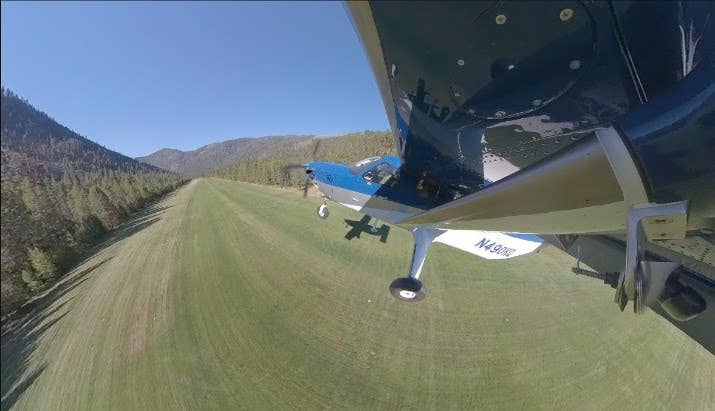Idaho Backcountry Airports Get Kodiak-Delivered Defibrillators
The donated AEDs will be networked via Wi-Fi for increased awareness.

The Kodiak 100 takes off from Johnson Creek Airport (3U2) in Yellow Pine, Idaho, to complete one of the Daher-sponsored defibrillator deployment flights in coordination with the Backcountry Aviation Defibrillator Project. [Courtesy: Daher]
You come to a stop, perched at the end of a strip in a remote wilderness, and the dust settles. You taxi carefully to the edge to position the airplane out of the way, so that the next pilot approaching has plenty of room to land. You step out onto the scrub and close the door behind you. The quiet descends.
There may not be another airplane coming, honestly. And it’s all fine as long as you’re fine, and all goes well. And what if the flight goes perfectly, but you or one of your group suffers a cardiac event while you’re setting up camp? It feels like an outside possibility—until it happens to someone you care about, and you’re many rugged miles from medical help.
As part of its effort to place critical care medical devices within several wilderness areas, the Backcountry Aviation Defibrillator Project is positioning automated external defibrillators (AEDs) at high-traffic remote airstrips across Idaho. The Zoll 3 units communicate via Wi-Fi to display their operational status—and in the future are proposed to broadcast their availability and status through flight planning applications.
The first of the missions to put these AEDs in place were conducted with the support of Daher using two of its Kodiak 100s, starting at Cavanaugh Bay Airport (66S) in Coolin near Daher’s Kodiak facility at Sandpoint in northern Idaho, and then going into other popular strips in the state: Big Creek Airport (U60) in Valley County and Johnson Creek (3U2) in Yellow Pine in the state’s central section; and to Smiley Creek (U87) about 35 miles north of Ketchum.
Nicolas Chabbert, senior vice president of Daher’s Aircraft Division and CEO of Kodiak Aircraft, flew the mission to Cavanaugh Bay.
“At Daher, our philosophy is: ‘We support those who care for aviation,’ and the Backcountry Aviation Defibrillator Project flights are a continuation of this commitment,” said Chabbert, noting the project makes a fitting complement to the company’s support of the Recreational Aviation Foundation and other backcountry missions.
Sam Perez, organizer for the Backcountry Aviation Defibrillator Project, thanked Daher for its support with an airplane most capable for the mission.
“The Idaho Aviation Association is exceptionally grateful for Daher's generosity and support of our mission to install these lifesaving defibrillators in Idaho's remote backcountry airstrips,” Perez said. “We could not have done so without the help of Daher and our many donors who helped pay for defibrillator units. Now, aviators and general aviation enthusiasts who use these remote airstrips will have a fighting chance should a cardiovascular event occur.”
Daher sponsored the AED in place at Cavanaugh Bay. Other donors included Lynn and Shirley McCullough (owners of a Daher TBM 910) at Big Creek; Dr. Jon Berman at Smiley Creek; and Rick Bosshardt at Johnson Creek.

Subscribe to Our Newsletter
Get the latest FLYING stories delivered directly to your inbox






